| An album of photographs from Chautauqua County, part of New York State's famous 'Burned-over District.' |
| Chautauqua County is the western-most county in New York State, and was part of the Holland Land Purchase, a real-estate investment scheme of 1792, whose eventual development took place in the early 19th century. The rectangular section-township-county pattern common throughout the mid- and far west already asserts itself in the Holland Land Purchase, owing to the influence of surveying innovations and a 'grid' mentality flowing from the Enlightenment, though the Purchase is not technically included in the Public Land Survey System. |
Lake Chautauqua, slashing diagonally across the county, is home to the famed Chautauqua Institution, one of the granddaddies of Methodist summer camps -- and the equally-famed muskellunge, a six-foot cousin of the northern pike highly sought out by anglers for its fight and spectacular acrobatics. [Catch-and-release is the rule today.] North of Lake Chautauqua, the land slopes toward Lake Erie and has long been one of America's most productive grape-growing regions. Long dominated by the demands of the Welch grape juice market for the Concord and Fredonia grapes, the area is now being devoted to more wineries with plantings of winemaking varietals, and there is a 'Wine Tasting Trail' in the Fredonia area. |
 In the colonial period, European fur traders -- primarily French -- traversed the area, home to the Seneca Nation, one of the members of the Iroquois Confederacy. Many French place names survive, as well as French phonetic spellings [such as Chautauqua] of Native American place names. There are two large Seneca reservations -- one in Erie County and one in Cattaragus County. In the colonial period, European fur traders -- primarily French -- traversed the area, home to the Seneca Nation, one of the members of the Iroquois Confederacy. Many French place names survive, as well as French phonetic spellings [such as Chautauqua] of Native American place names. There are two large Seneca reservations -- one in Erie County and one in Cattaragus County. |
 Fredonia (my hometown) is a village in the Town of Pomfret. Settled in the first decade of the 19th century by families migrating from New England, it betrays its New England roots in the Barker Commons, two 2-acre greens that sit astride the main north-south road and alongside the east-west thoroughfare, US Route 20. Fredonia (my hometown) is a village in the Town of Pomfret. Settled in the first decade of the 19th century by families migrating from New England, it betrays its New England roots in the Barker Commons, two 2-acre greens that sit astride the main north-south road and alongside the east-west thoroughfare, US Route 20.Each of the squares is laid out in a classic X-pattern with large cast-iron fountains at the center of each. A bandstand in one provides a setting for outdoor summer concerts. In the earliest days, the commons were kept neat by grazing sheep. US Route 20, Fredonia's 'Main Street' is one of America's first cross-country highways, running from Boston, Massachusetts all the way to a mile from the Pacific Ocean in Newport, Oregon. Before the days of Interstate highways, it was as busy as Route 66 -- if never as famous. |
 In 1825, the Marquis de Lafayette visited the little western settlement on his year-long visit to America in advance of the 50th anniversary of the Revolution. The tiny village honored him with the inaugural lighting of the streets with natural gas lamps fed by gas piped from the first gas well in the United States. The populist strain which is part of the local history may be glimpsed in the plaque commemorating the event, which refers to him simply as 'General Lafayette.' In 1825, the Marquis de Lafayette visited the little western settlement on his year-long visit to America in advance of the 50th anniversary of the Revolution. The tiny village honored him with the inaugural lighting of the streets with natural gas lamps fed by gas piped from the first gas well in the United States. The populist strain which is part of the local history may be glimpsed in the plaque commemorating the event, which refers to him simply as 'General Lafayette.' |
| The coming of the railroads, the Civil War and the advent of industrialism radically transformed the little village. The neighboring village of Dunkirk, on the Lake and so-named because of its similarity to the harbor of Dunkerque, France, developed into a steel, tool and locomotive manufacturing center, owing in great part to being on the New York Central and Nickel Plate rail lines. |
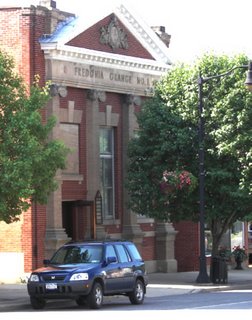 The first local Grange in the US was organized in Fredonia in April, 1868. The Grange, or Patrons of Husbandry, was an organization dedicated to promoting the interests of farmers in the developing age of the 'robber barons.' Among other things, Grangers fought against the stranglehold the railroads held over transportation prices. Grangers also lobbied for what became the Agricultural Extension Services of the land-grant universities; Rural Free Delivery (R.F.D. to those of us who grew up relying on it) by the Post Office -- as important for merchandise from Sears and Wards as for mail; and the Farm Credit system meant to help farmers over rough patches. (Charles Gilliam has also written a brief history of the Grange.) Fredonia's local is still active as a Grange and also hosts the local preservation society and the Unitarian-Universalist congregation. The first local Grange in the US was organized in Fredonia in April, 1868. The Grange, or Patrons of Husbandry, was an organization dedicated to promoting the interests of farmers in the developing age of the 'robber barons.' Among other things, Grangers fought against the stranglehold the railroads held over transportation prices. Grangers also lobbied for what became the Agricultural Extension Services of the land-grant universities; Rural Free Delivery (R.F.D. to those of us who grew up relying on it) by the Post Office -- as important for merchandise from Sears and Wards as for mail; and the Farm Credit system meant to help farmers over rough patches. (Charles Gilliam has also written a brief history of the Grange.) Fredonia's local is still active as a Grange and also hosts the local preservation society and the Unitarian-Universalist congregation. |
| Being in the 'burned-over district' means having experienced the waves of religious enthusiasms and revival that spread across the region throughout the 19th century. From Mormonism to Free Methodism, from Spiritualism to Fourierism, the area saw every great movement of the 19th century -- except Shakerism. Part of that experience was the phenomenal growth of the anti-saloon or teetotaling movement, spearheaded by women from the mainline Baptist and Methodist denominations. In the winter of 1873-74, "Women's Crusades" were held in Fredonia's First Baptist Church and in two Ohio towns. Women would enter saloons and fall to their knees in pray-ins, demanding the sale of liquor cease. Realizing the need for organizational coordination, the groups met in Cleveland, Ohio in November 1874 to found the National Women's Christian Temperance Union, the oldest continuing non-sectarian women's group in the world. The local WCTU gave a public water fountain which is in use to this day. Though my maternal grandmother was a supporter and 'took the pledge' never to drink, I must report that there seemed more saloons on last weekend's visit than there were when I left for college in 1956. Education was another area in which the village led the way. The founders had brought with them New England ideas of the importance of schooling, and one gave land in 1822 for an Academy, on the proviso the citizens would raise the funds through a subscription to erect a building. The first class enrolled in 1826. |
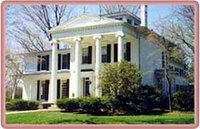 Students paid for their courses, and the curriculum was more like what we would consider a public school education, but it served the community's needs well for forty years. In 1866, the Academy was merged into the newly organized, state-funded Normal School, which prepared students for teaching careers at no expense. Students paid for their courses, and the curriculum was more like what we would consider a public school education, but it served the community's needs well for forty years. In 1866, the Academy was merged into the newly organized, state-funded Normal School, which prepared students for teaching careers at no expense.I was present at, and shook the hand of Gov. Tom Dewey [as a very young boy], when he dedicated a new dormitory after the formation of the State University of New York in 1948. Fredonia is one of its colleges, known today as SUNY-Fredonia. |
| The 1891 Opera House has been completely restored and provides a venue for concerts and theater performances throughout the year. The building also house the Village of Fredonia offices, police station and jail. The Opera House was well-known on the vaudeville circuit in the early 20th century, and the Marx Brothers fondly refer to Fredonia -- where they performed many times -- in their movie Duck Soup. On the weekend I visited, the block in front of the building was closed to traffic for a busy farmers' market.  Neighboring Dunkirk, which boasted three mills (two steel mills and a locomotive works -- where my father worked), was devastated by the changes wrought by changing technology. (In 1954, the American Locomotive Works was still building steam locomotives in its Dunkirk plant!) Neighboring Dunkirk, which boasted three mills (two steel mills and a locomotive works -- where my father worked), was devastated by the changes wrought by changing technology. (In 1954, the American Locomotive Works was still building steam locomotives in its Dunkirk plant!)Though having lost about half its 18,000 population in the past 50 years, it is experiencing a renaissance of sorts as tourism and a marina have made the harbor a bustling scene. |
| Leaving Fredonia to return home, I passed through the Village of Cassadaga, which sits on lovely twin lakes whose shoreline is lined with flowering waterlilies in gorgeous shades of yellow, pink and white. Adjacent to the village is the Lily Dale Assembly, the private Spiritualist community known world-wide. A little frayed at the edges, it is mobbed in the summer time with seekers and spiritualists who come for the annual classes and seances. 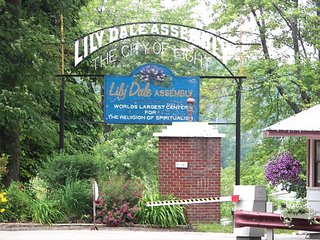 I have many fond childhood memories of the settlement as my mother's best friend was the telephone operator for the community. The switchboard was in a spare bedroom and she was on call 24/7. And considered herself lucky to have the job. How times have changed! I have many fond childhood memories of the settlement as my mother's best friend was the telephone operator for the community. The switchboard was in a spare bedroom and she was on call 24/7. And considered herself lucky to have the job. How times have changed!On the hill west of the Assembly stood a tuberculosis sanatorium where my mother's brother was once treated during the 1940s. The hills to the west and south of Cassadaga mark the point where Chautauqua County starts its tip toward Lake Erie. Consequently, these waters drain southward, and the Cassadaga Creek flows through the valley to join the Allegheny River in Pennsylvania. The Allegheny flows into the Ohio, which then joins the great Mississippi. |
So, in one sense it is not inaccurate to say that the spring-fed lake at the edge of the Lily Dale Assembly flows into the Gulf of Mexico. -- Dan Damon |
Sunday, July 09, 2006
A Burned-Over District album
Subscribe to:
Post Comments (Atom)
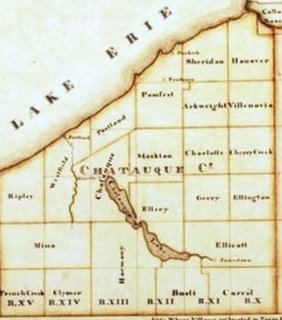
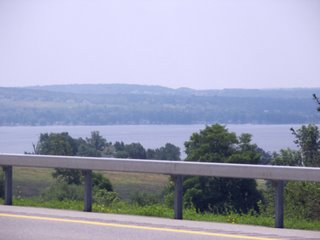


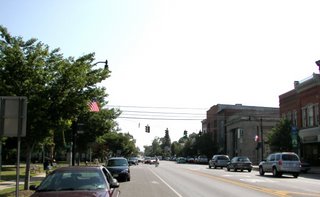

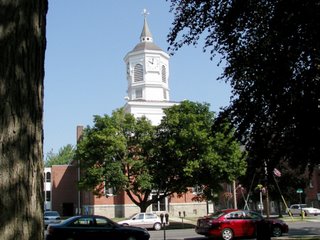
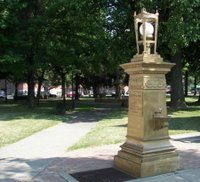


No comments:
Post a Comment